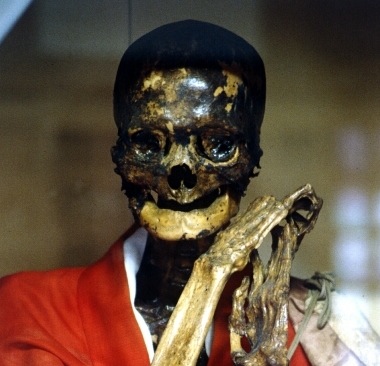
Say hello to Arisada Hōin 宥貞法印, a monk of the Kanshū-ji 貫秀寺 in Asakawa (Fukushima prefecture)!
In reading up about Kūkai and the Shingon school of esoteric Buddhism for my thesis, I stumbled upon about the somewhat creepy practice of self-mummification called sokushinbutsu. The mummy pictured above wasn’t embalmed posthumously as Egyptian mummies were, but rather started out as a healthy man who slowly mummified himself alive over the course of eight years. The first step to this was to burn away all his body fat through a special diet and ascetic practice, and in the final phase, he would be entombed alive in a stone room just big enough for him to sit lotus style in for thousand days. As long as the man could ring a bell each day a tube remained in place to supply air; but when the bell finally stopped, the tube was removed and the tomb was opened. If the preservation was perfect (i.e., the monk was still sitting in his lotus position) his body was removed from the tomb, and put on display. Those who failed to preserve themselves were sealed into their tombs. Read more about the process of self-mummification here.
Self-mummification was practiced from the 11th century up to the early 20th century among monks in Northern Japan; some claim that the foundations of the practice can be traced back to the esoteric belief system of sokushin jōbutsu (attainment of Buddha-hood in this body) developed by Kūkai in the 9th century. However, it should best be regarded as an extreme form of Shugendō practice. Sokushinbutsu was not regarded as suicide by its practitioners, but rather as a slow process of divorcing oneself from the material world in order to attain Buddha-hood.
Hori Ichirō, best known in the West as the author of a classic work on Japanese folk religion, was among the first to do field research and publish about this phenomenon in English in the early 1960s. I am not aware of any more recent academic writings on the subject, but check out this well-written article by CJ Mathews, which is just a few days old, and this website. Also, Gabi Greve has put together a site with a lot of information about the various mummies found throughout Japan. There are between 16 and 24 well-preserved sokushinbutsu left today.
Edit
Buried in a PDF file on Prof. Christoph Kleine’s home page I found a short bibliography on sokushinbutsu and similarly extreme rituals in Japanese religion. I will take the liberty to reproduce it here, for anybody interested in reading more about this topic:
Benn, James A. “Passage to Fudaraku: Suicide and Salvation in Premodern Japanese Buddhism.” In The Buddhist Dead: Practices, Discourses, Representations, edited by Bryan J. Cuevas, Jacqueline Ilyse Stone and Kuroda Institute, x, 491 p. Honolulu: University of Hawai’i Press, 2007.
Earhart, Byron H. “Ishikozume: Ritual Execution in Japanese Religions, especially in Shugendō.” Numen 13, no. 2 (1966): 116-27.
Faure, Bernard. Der Tod in den asiatischen Religionen, Domino; 15. Bergisch Gladbach: BLT, 1999.
Hori, Ichiro. “Self-Mummified Buddhas in Japan: An Aspect of the Shugen-dō (‘Mountain Asceticism’) Sect.” History of Religions 1, no. 2 (1961): 222-42.
Kabanoff, Alexander. “Buddhism and Popular Religion in the Tokugawa Period.” In Enkū (1632-1695); Timeless Images from 17th Century Japan, edited by Jan Van Alphen. Antwerpen:
Etnografisch Museum Antwerpen, 1999.
Kleine, Christoph. “Sterben für den Buddha, Sterben wie der Buddha: Zu Praxis und Begründung ritueller Suizide im Ostasiatischen Buddhismus.” Zeitschrift für Religionswissenschaft 11, no. 1 (2003): 3-43.
Kleine, Christoph. “‘The Epitome of the Ascetic Life’: The Controversy over Self-Mortification and Ritual Suicide as Ascetic Practices in East Asian Buddhism.” In Asceticism and Its Critics: Historical Accounts and Comparative Perspectives, edited by Oliver Freiberger, 153-77. Oxford; New York: Oxford University Press, 2006.
Pinguet, Maurice. Der Freitod in Japan: Geschichte der japanischen Kultur. Translated by Beate von der Osten; Makoto Ozaki; Walther Fekel. 2. ed. Frankfurt a.M.: Gatza bei Eichborn, 1996.
